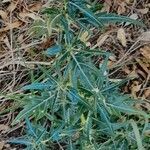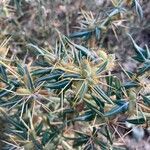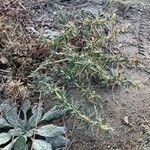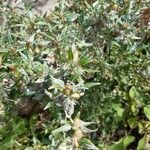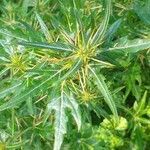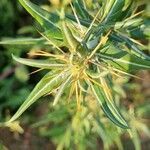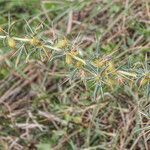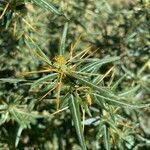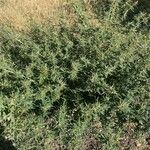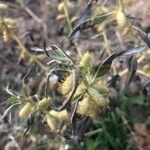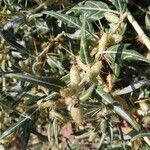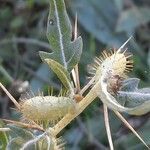Herb (0.1–) 0.3–1.0 (–1.5) m high; stems pubescent, armed with rigid 3-pronged spines at base of leaves; spines 7–25 mm long, yellowish. Leaves: petiole 5–10 mm long; lamina narrowly rhombic to lanceolate, 20–80 (–110) mm long, 8–22 (–40) mm wide, entire or 3-(–5-) lobed; lobes broad, deltoid, extending not more than ½ way to midrib; upper surface dark green, with 1 or 3 whitish veins, shiny and ± pubescent; lower surface white-felted. Male capitula in terminal globular clusters, or in upper leaf axils. Female capitula usually solitary. Conceptacles (9–) 10–12 (–13) mm long, with mainly woolly hairs, and occasional sessile glandular hairs, plus numerous hooked glabrous spines 2–3 mm long. Terminal spines slender, 1–2 mm long.
Plants 3–12 dm, the stems strigose or puberulent; lvs lanceolate, entire or with a few coarse teeth or pinnate lobes, tapering to each end, short-petiolate, 2.5–6 × 0.5–2.5 cm, sparsely strigose or glabrate above, except for the usually more hairy main veins, densely silvery-sericeous beneath, bearing a tripartite yellow spine 1–2 cm in the axil; burs mostly solitary or few in the axils, cylindric, ca 1 cm, beakless or with a single short beak, finely puberulent and provided with slender, hooked prickles; 2n=36. Waste places; now a cosmopolitan weed in the warmer parts of the world, and occasionally found in our range. July–Oct. (Acanthoxanthium s.)
Coarse, annual herb, up to 1 m high; stem yellowish. Leaves alternate, narrowly rhomboidal, commonly 3-lobed; white-felted below. Male capitula spherical, in upper leaf axils; involucre short; bracts few, narrow, in 1 or 2 rows; receptacle hemispherical, paleate; corolla tubular, 5-toothed; anthers with small apical appendage, base obtuse; filaments connate; ovary abortive; style undivided. Female capitula solitary, in lower leaf axils; involucre completely enveloping 2 female florets, 2-locular within; corolla absent; style branches long, linear, acute. Pappus absent. Cypselae ellipsoid, closely covered in hooked spines, inconspicuous.
Annual herb, up to 1 m high. Leaves alternate; blade narrowly rhomboidal, usually 3-lobed, apical lobe long and narrow, margins entire, prominently discolorous; petiole ± 10 mm long, each subtended by yellow trifid spine. Heads unisexual, discoid; male heads many in upper leaf axils; female heads solitary in lower leaf axils. Involucral bracts in male heads few, narrow, 1-or 2-seriate; in female heads enveloping female florets, covered in hooked spines. Flowers: corolla of male florets greenish, absent in female florets; Dec.-Mar. Fruit with cypsela obovoid or oblong, enveloped by hardened, spiny involucral bracts. Pappus absent.
Coarse annual herb to about 1 m, stem yellowish with a yellow trifid spine subtending each petiole. Leaves alternate, petiole c. 1 cm long, lamina up to c. 8 x 2 cm, narrowly rhomboidal, commonly 3-lobed, the apical lobe very long and narrow, margins entire, dark green above drying blackish, white-felted below. Male heads spherical, 4-5 mm across, in the upper leaf axils. Female heads solitary in lower leaf axils. Fruiting heads (burs) ellipsoid, 8-12 mm long, closely covered in hooked spines, the 1 or 2 apical horns straight, shorter than the spines, inconspicuous, sometimes wanting.
Herbs, annual, 10-60(-120) cm; nodal spines usually in pairs, simple or 2-or 3-partite, 15-30 mm. Petiole 1-15(-25) mm; leaf blade ± ovate to lanceolate or lanceolate-linear, 4-8(-12) × 1-3(-5) cm, often pinnately 3(-7)-lobed, abaxially gray to white, densely strigose. Burs 10-12(-15) mm. Fl. Jul-Oct. 2n = 36.
Plants 10–60(–120+) cm; nodal spines usually in pairs, simple or 2–3-partite, 15–30+ mm. Leaves: petioles 1–15(–25+) mm; blades ± ovate to lanceolate or lance-linear, 4–8(–12+) × 1–3(–5+) cm, often pinnately 3(–7+)-lobed, abaxial faces gray to white, densely strigose. Burs 10–12(–15+) mm. 2n = 36.
A medium sized stiffly branched annual herb. It grows 1 m high. It has simple or 3 forked yellowish spines at the base of each leaf. The fruit heads are 8-12 mm across. They are covered with dense, hooked spines.
Annual herb, up to 1 m high, with trifid spines subtending petiole. Leaves narrowly rhomboidal, very discolorous. Flowers greenish.
